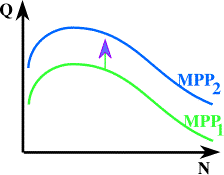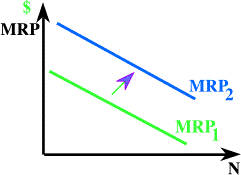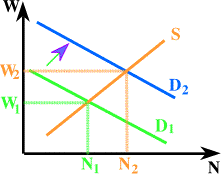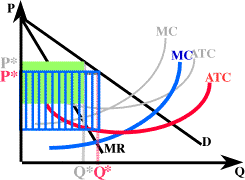Department of Labor Reports Productivity Increase for US Workers
December 1, 1997

- Relevant Review:
- Factor Markets
- Factor Demand
- Monopoly
- Cost Change
The [Outside Econweb] US Department of Labor reported an annual rate of growth of 4.5% in the productivity
of US workers for the three month period from July through September
1997, the fastest rate of increase in productivity since the fourth
quarter of 1992.
An increase in productivity is about the only piece of economic
news that seems to have no down side. Let's look at some of the
microeconomic effects of increased productivity to see why.
First, as you no doubt recall from your study of Factor Markets, the demand curve for any factor of production, including labor
is the Marginal Revenue Product (MRP) curve, since MRP gives the added revenue for each added unit of the factor. MRP in turn is the product of Marginal Physical Product (MPP) and Marginal Revenue (MR).
 To the left is a graph of a Marginal Physical Product curve shifting upward. The MPP curve for US Workers, if we graphed it, would show an upward
shift during the July-September quarter (though not as large of
course). Along the horizontal axis N represents numbers of workers
and on the vertical axis is Q, output. MPP is the added or marginal output of an additional worker. An increase
in MPP means that if the firm hires another worker output will increase
by more than before, the Marginal Product of the worker has risen.
To the left is a graph of a Marginal Physical Product curve shifting upward. The MPP curve for US Workers, if we graphed it, would show an upward
shift during the July-September quarter (though not as large of
course). Along the horizontal axis N represents numbers of workers
and on the vertical axis is Q, output. MPP is the added or marginal output of an additional worker. An increase
in MPP means that if the firm hires another worker output will increase
by more than before, the Marginal Product of the worker has risen.
 Since the Marginal Revenue Product of labor is also the demand for labor for any profit maximizing
firm a shift in MPP also shifts the MRP curve, as shown to the right. This also means that the demand
curve for labor shifts up.
Since the Marginal Revenue Product of labor is also the demand for labor for any profit maximizing
firm a shift in MPP also shifts the MRP curve, as shown to the right. This also means that the demand
curve for labor shifts up.
Something that many new economics students find troubling is
the idea that firms will hire more workers if workers become more
productive. The first instinct is just the opposite, that a firm
will need fewer workers since each worker now produces more output.
The trick here is to keep in mind that a more productive worker
is actually a cheaper worker. Labor costs per unit of output are
lower if workers are more productive. If an input (labor in this
case) is cheaper more will be hired since the firm can lower costs
and increase output, thus increasing profits.
 The labor market effects will tend to be as shown to the left.
Because the demand for workers has risen from D1to D2(since demand is just MRP), numbers hired increase from N1to N2and wages increase from W1to W2. Unlike what, at first thought, might be expected to happen,
an increase in productivity will tend to increase wages and numbers employed.
The labor market effects will tend to be as shown to the left.
Because the demand for workers has risen from D1to D2(since demand is just MRP), numbers hired increase from N1to N2and wages increase from W1to W2. Unlike what, at first thought, might be expected to happen,
an increase in productivity will tend to increase wages and numbers employed.
Now, this increase hiring probably won't occur in industries
that have colluded to keep output low and prices high since this
behavior is somewhat different from pure profit maximizing behavior
(though it has the same intent). The alert student will comment
that such collusion is illegal. The alert professor will remind
the student that illegal activities still occur, such as underage
drinking, speeding, and collusion to name a few. That's why we
have police, and for collusion the [Outside Econweb] US Department of Justice, and the [Outside Econweb] Federal Trade Commission, with similar problems that police face in stemming crime. We also remind the student that industries can agree to
keep output down without actively colluding, see the section on
oligopoly.
 Within the typical profit maximizing firm we can see the increase
in worker productivity as a reduction in variable costs as shown
to the right. We show a firm with a downward sloping demand curve
that was already earning profits (green shaded area) before the increase in productivity. After productivity increases,
variable costs fall shifting down the MC and ATC curves. Because MC is lower the firm produces more output (see why it will hire
more workers?) and sells it at a lower price. At the same time
profits increase to the blue striped area.
Within the typical profit maximizing firm we can see the increase
in worker productivity as a reduction in variable costs as shown
to the right. We show a firm with a downward sloping demand curve
that was already earning profits (green shaded area) before the increase in productivity. After productivity increases,
variable costs fall shifting down the MC and ATC curves. Because MC is lower the firm produces more output (see why it will hire
more workers?) and sells it at a lower price. At the same time
profits increase to the blue striped area.
Whatever else goes on in any economy, producing needed goods
and services with the fewest resources is the ultimate goal. Increased
productivity is good news all the way around. Too bad it isn't
easier to attain.
Copyright © 1995-2003 OnLineTexts.com, Inc. - All Rights Reserved
 To the left is a graph of a Marginal Physical Product curve shifting upward. The MPP curve for US Workers, if we graphed it, would show an upward
shift during the July-September quarter (though not as large of
course). Along the horizontal axis N represents numbers of workers
and on the vertical axis is Q, output. MPP is the added or marginal output of an additional worker. An increase
in MPP means that if the firm hires another worker output will increase
by more than before, the Marginal Product of the worker has risen.
To the left is a graph of a Marginal Physical Product curve shifting upward. The MPP curve for US Workers, if we graphed it, would show an upward
shift during the July-September quarter (though not as large of
course). Along the horizontal axis N represents numbers of workers
and on the vertical axis is Q, output. MPP is the added or marginal output of an additional worker. An increase
in MPP means that if the firm hires another worker output will increase
by more than before, the Marginal Product of the worker has risen. 
 Since the Marginal Revenue Product of labor is also the demand for labor for any profit maximizing
firm a shift in MPP also shifts the MRP curve, as shown to the right. This also means that the demand
curve for labor shifts up.
Since the Marginal Revenue Product of labor is also the demand for labor for any profit maximizing
firm a shift in MPP also shifts the MRP curve, as shown to the right. This also means that the demand
curve for labor shifts up.  The labor market effects will tend to be as shown to the left.
Because the demand for workers has risen from D1to D2(since demand is just MRP), numbers hired increase from N1to N2and wages increase from W1to W2. Unlike what, at first thought, might be expected to happen,
an increase in productivity will tend to increase wages and numbers employed.
The labor market effects will tend to be as shown to the left.
Because the demand for workers has risen from D1to D2(since demand is just MRP), numbers hired increase from N1to N2and wages increase from W1to W2. Unlike what, at first thought, might be expected to happen,
an increase in productivity will tend to increase wages and numbers employed.  Within the typical profit maximizing firm we can see the increase
in worker productivity as a reduction in variable costs as shown
to the right. We show a firm with a downward sloping demand curve
that was already earning profits (green shaded area) before the increase in productivity. After productivity increases,
variable costs fall shifting down the MC and ATC curves. Because MC is lower the firm produces more output (see why it will hire
more workers?) and sells it at a lower price. At the same time
profits increase to the blue striped area.
Within the typical profit maximizing firm we can see the increase
in worker productivity as a reduction in variable costs as shown
to the right. We show a firm with a downward sloping demand curve
that was already earning profits (green shaded area) before the increase in productivity. After productivity increases,
variable costs fall shifting down the MC and ATC curves. Because MC is lower the firm produces more output (see why it will hire
more workers?) and sells it at a lower price. At the same time
profits increase to the blue striped area.